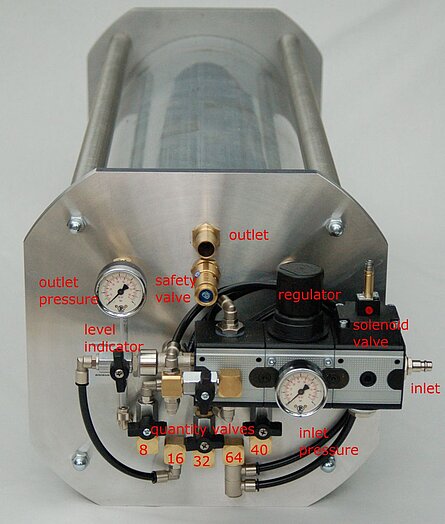
It is quite obvious that potential hazards associated with the use of aerosol-baasd seeding need to be addressed when using PIV in order to minimize effects of the seeding aerosols on humans or the environment.
Introduction
The presentation ‘Particulate Matter’ by Patrick N. Breysse and Peter J.S. Lees of the Johns Hopkins University provides an excellent introduction to this topic.
http://ocw.jhsph.edu/courses/PrinciplesIndustrialHygiene/PDFs/Lecture4.pdf
Chemical substances
For many chemical substances, including some which are used for seeding flows, information about their hazard is available as safety data sheets in a structured format with topics such as:
- Identification
- Hazards identification
- Composition/information on ingredients
- First-aid measures
- Fire-fighting measures
- Accidental release measures
- Handling and storage
- Exposure controls/personal protection
- Physical and chemical properties
- Stability and reactivity
- Toxicological information
- Ecological information
- Disposal considerations
- Transport information
- Regulatory information
- Other information
Each PIV laboratory should make available such data sheets for seeding materials as used by them for information of its personnel.
As an example links are provided data sheets for e.g. Di-Ethyl-Hexyl-Sebacat (DEHS), a chemical substance which, due to its properties (comparably long life-time of droplets, but complete evaporation after long times), has found wide-spread use in PIV applications in air flows.
United States, manufacturer of DEHS:
Germany, specialist for aerosol technologies and user of DEHS:
Tracer particles used for PIV
Many PIV applications in air flows make use of liquid or solid tracer particles with diameters in the range of 0.3 µm to 1.5 µm. For PIV applications in water solid tracer particles with diameters in the range of 10 to 50 µm are commonly used. As described in detail in the book, these diameters are determined as a trade-off between adequate particle following behavior within the flow and the light scattering efficiency of the particles. PIV theory and experiment show that about 10 particles images should be present within an interrogation volume in order to obtain reliable velocity data. From these data, together with the flow velocity and the cross section of the seeded flow, the minimum number of particles per second, resp. the minimum mass of the seeding material per second, as required for the PIV experiment can be estimated.
Whereas for liquid flows the tracer particles stay within the liquid and usually do not provide additional harm to the PIV user, for air flows it is necessary to assess any additional hazards due to the fact, that the seeding substances will be used as aerosol to form the tracer particles required for the PIV experiment.
Hazard of aerosols
The hazard of such tiny aerosol particles to humans is quite obvious. For example, Chapter 10 of the Encyclopedia of Occupational Health and Safety
http://www.ilocis.org/documents/chpt10e.htm
describes in detail how aerosols are inhaled by the human lung.
This means that the amount of aerosol inserted in the test facility of the PIV experiment along with the exposure to personnel must be minimized as best as possible, e.g.
- controlled production of the aerosol, by using a cascadable seeding generator to produce just that amount of aerosol as required for the experiment, and impactors to get rid of big particles, which are of no use for the PIV experiment,
- injection of the aerosol into the flow, by seeding only those stream tubes of the flow, which will pass through the PIV observation volume,
- using remote control (magnetic valves) for the air supply of the aerosol generator, to allow aerosol production only, if it is required for the ongoing PIV measurement,
- designing the experimental set-up in such a way, that the aerosol stays within a confined domain, or, if this is not possible, to provide the personnel with appropriate breathing masks, to exhaust the seeded flow to the outside of the laboratory and to exchange the air within the laboratory immediately after the PIV experiment.
Test facility and laboratory
The contamination of the windows of the test section (which affects the quality of the PIV recordings), the walls of the test section and of screens and grids in wind tunnels due to the tracer particles must be minimized. Usually, facility and application dependent solutions have to be developed, taking into account the chemical substance(s) used for seeding of the flow and the type of flow to be investigated.
In order to avoid any hazards, each PIV laboratory must strictly follow any technical and legal requirements related to seeding safety, in particular, must have readily available all required technical and legal documents for information of its personnel, display the most important information in the laboratory or test facility, and is required to train its personnel in regular intervals.
Contents provided by Markus Raffel and Jürgen Kompenhans, 20180327
